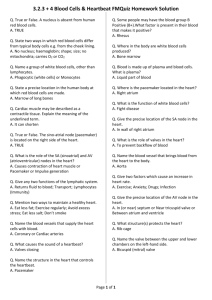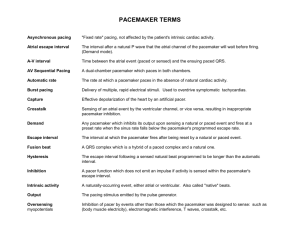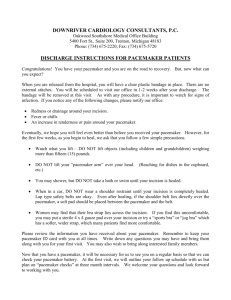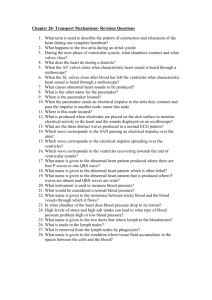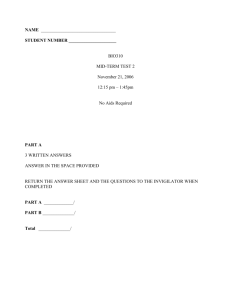Understanding pacemaker codes First letter Second letter Third
advertisement
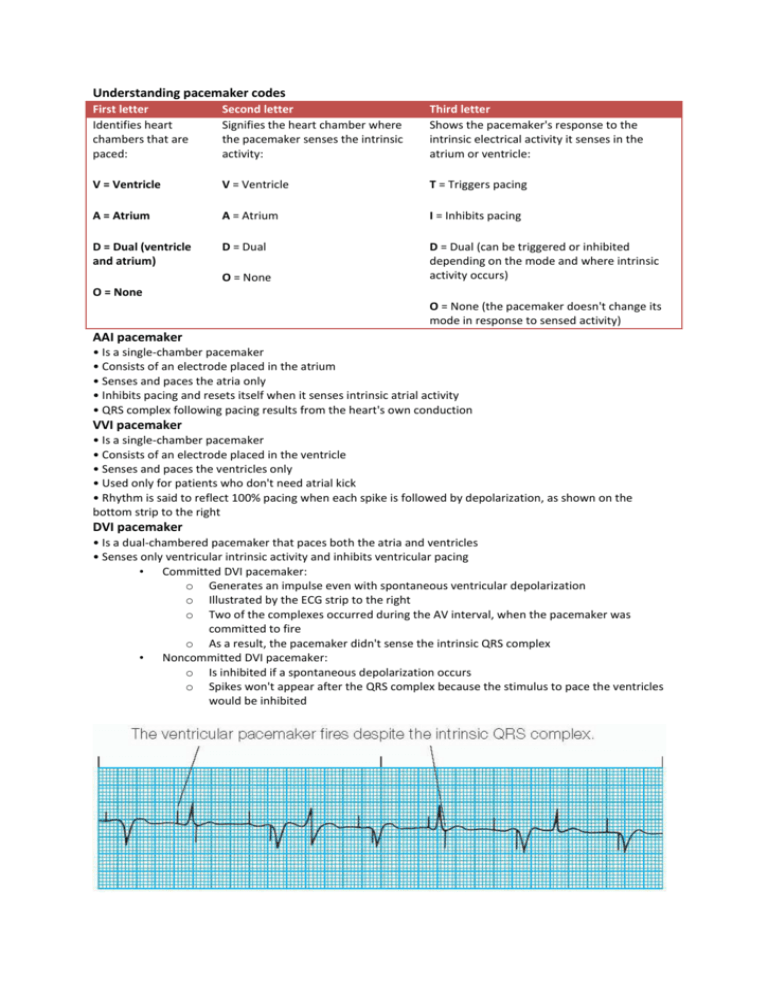
Understanding pacemaker codes First letter Identifies heart chambers that are paced: Second letter Signifies the heart chamber where the pacemaker senses the intrinsic activity: Third letter Shows the pacemaker's response to the intrinsic electrical activity it senses in the atrium or ventricle: V = Ventricle V = Ventricle T = Triggers pacing A = Atrium A = Atrium I = Inhibits pacing D = Dual (ventricle and atrium) D = Dual D = Dual (can be triggered or inhibited depending on the mode and where intrinsic activity occurs) O = None O = None O = None (the pacemaker doesn't change its mode in response to sensed activity) AAI pacemaker • Is a single-chamber pacemaker • Consists of an electrode placed in the atrium • Senses and paces the atria only • Inhibits pacing and resets itself when it senses intrinsic atrial activity • QRS complex following pacing results from the heart's own conduction VVI pacemaker • Is a single-chamber pacemaker • Consists of an electrode placed in the ventricle • Senses and paces the ventricles only • Used only for patients who don't need atrial kick • Rhythm is said to reflect 100% pacing when each spike is followed by depolarization, as shown on the bottom strip to the right DVI pacemaker • Is a dual-chambered pacemaker that paces both the atria and ventricles • Senses only ventricular intrinsic activity and inhibits ventricular pacing • Committed DVI pacemaker: o Generates an impulse even with spontaneous ventricular depolarization o Illustrated by the ECG strip to the right o Two of the complexes occurred during the AV interval, when the pacemaker was committed to fire o As a result, the pacemaker didn't sense the intrinsic QRS complex • Noncommitted DVI pacemaker: o Is inhibited if a spontaneous depolarization occurs o Spikes won't appear after the QRS complex because the stimulus to pace the ventricles would be inhibited DDD pacemaker • Set with a rate range rather than a single critical rate • Senses atrial activity and ensures that the ventricles respond to each atrial stimulation • Fires when the ventricle doesn't respond on its own • Paces the atria when the atrial rate falls below the lower set rate • Illustrated by the ECG strip to the right o o o o o o Complexes 1, 2, 4, and 5 reveal the atrial synchronous mode set at a rate of 70. The patient has an intrinsic P wave so the pacemaker only makes sure the ventricles respond. Complexes 3, 5, 8, 10, and 12 are intrinsic ventricular depolarizations. The pacemaker senses these depolarizations and inhibits firing. In complexes 6, 9, and 11, the pacemaker is pacing both the atria and the ventricles in sequence. In complex 13, only the atria are paced; the ventricles respond on their own. Pacemaker malfunctions • Malfunction may lead to arrhythmias, hypotension, syncope, and other signs and symptoms of decreased cardiac output. • Common problems include failure to capture or stimulate the heart chamber, failure to pace or produce activity, and under sensing. Failure to capture • Results when the pacemaker fails to stimulate the heart chamber • Reflected on the ECG by a pacemaker spike without the appropriate atrial or ventricular response (a spike without a complex) • May occur because of increased pacing thresholds related to: o metabolic or electrolyte imbalance o antiarrhythmics o fibrosis or edema at the pacemaker electrode tip o dislodged, broken, or damaged lead o perforation of the myocardium by the lead o loose connection between the lead and the pulse generator Failure to pace • Reflected by an ECG that shows no pacemaker activity when pacemaker activity should be evident • Also reflected by a lack of response to magnetic application • May result because of: o circuit failure o inappropriate programming o electromagnetic interference o depleted battery Failure to sense intrinsic beats • Also referred to as undersensing • Reflected by an ECG that may show pacing spikes anywhere in the cycle, including where intrinsic cardiac activity is present • May cause the patient to feel palpitations or skipped heart beats • May trigger ventricular tachycardia or fibrillation if a spike falls on a T wave • May occur because of: o battery failure o fracture of the pacing lead wire o displacement of the electrode tip o “cross-talk” between atrial and ventricular channels o electromagnetic interference mistaken for intrinsic signals
